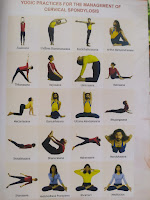Yogic Mangement of CERVICAL SPONDYLOSIS
Cervical spondylosis is a common degenerative condition of the cervical spine. It is a condition involving changes to the bones, discs, and joints of the neck. It is most likely caused by age-related changes in the inter-vertebral disks. These changes are caused by the normal wear-and-tear of aging. With age, the discs of the cervical spine gradually lose fluid, and become stiffer. Clinically, several overlapping and distinct syndromes are seen. These include neck and shoulder pain, sub-occipital pain and headache.
To a certain extent, we all develop a degree of degeneration in the vertebrae and discs as we become older. More than 80% of the people over the age of 60 are affected. As the 'discs' degenerate over the years, they become thinner. Sometimes the adjacent vertebrae develop small, rough areas of bone on their edges. The nearby muscles, ligaments and nerves may become irritated by these degenerative changes which can cause troublesome symptoms.
Spondylosis is degenerative arthritis, osteoarthritis of the spinal vertebra and related tissue. If severe, it may cause pressure on nerve roots with subsequent pain or paresthesia in the limbs.
Neck pain is one of the most common problems that one encounters in day to day life. It is probably as common as common cold.
When the space between two adjacent vertebrae narrows, compression of a nerve root emerging from the spinal cord may result in radiculopathy (sensory and motor system disturbances, such as severe pain in the neck, shoulder, arm, back, accompanied by muscle weakness). Less commonly, direct pressure on the spinal cord (typically in the cervical spine) may result in weakness, gait dysfunction, loss of balance. The patient may experience tingling, numbness and weakness in the arms and hands because of nerve compression and lack of blood flow.
Causes of cervical spondylosis
Cervical spondylosis results from chronic degeneration of the cervical spine including the cushions between the neck vertebrae (cervical disks) and joints between the bones of the cervical spine. There may be abnormal growths or "spurs" on the vertebrae (the bones of the spine - Osteophytes).
These accumulated changes caused by degeneration can gradually
compress one or more of the nerve roots. This can lead to increasing
pain in the neck and arm, weakness, and changes in sensation. In
advanced stages, the spinal cord becomes involved. This can affect
not just the arms, but the legs as well.
A previous neck injury (which may have occurred several years prior) can predispose to spondylosis, but the major risk factor is aging. By the age of 60, 70% of women and 85% of men show changes consistent with cervical spondylosis on x-ray.
Symptoms of cervical spondylosis
• Neck pain (may radiate to the arms or shoulder)
• Loss of sensation or abnormal sensations of the shoulders, arms, or (rarely) legs
• Weakness of the arms or (rarely) legs
• Neck stiffness that progressively worsens
• Loss of balance
• Headaches, particularly at the back of the head
• Loss of control of the bladder or bowels (if spinal cord is compressed)
Risk Factors
Risk factors for cervical spondylosis include:
Age :
Cervical spondylosis is a normal wear-and-tear of aging. Spinal disks tend to dehydrate and shrink with the age.
Occupation:
Certain jobs may place extra stress on your neck. This may include repetitive neck motions, wrong sitting postures or a lot of overhead work.
Neck injuries:
Previous neck injuries appear to increase the risk of cervical spondylosis.
Genetic factors:
Some families will have more of these changes over time, while other families will develop less.
Yogic Management of cervical spondylosis
1. Neck and Spinal exercises:
The simple exercises of neck movements facilitate the practice of further range of Yogic techniques by loosening the joints and relax the muscles. These practices are backward, sideward (turning and bending) and twisting movements.
2. Sukshma Vyayama :
Griva-sakti-vikasaka (Strengthening the Neck) (1) (Exercise A & B), Griva-sakti-vikasaka (Strengthening the Neck) (2 & 3), Skandha tatha bahu-mula sakti-vikasaka (Developing the Strength of the Shoulder-Blades & Joints), Purna-bhuja-sakti-vikasaka (Developing the Arms).
3. Yoga for cervical spondylosis
Tadasana, Urdhwa Hastottanasana, Katichakrasana, Ardhachakrasana, Konasana, Vajrasana, Ushtrasana, Vakrasana, Ardhamatsyendrasana, Marjari-asana, Gomukhasana, Uttanamandukasana, Sarala Matsyasana, Bhujangasana, Shalabhasana, Dhanurasana, Makarasana, Shavasana.
4. Pranayama for cervical spondylosis
Nadishuddhi, Suryabhedana and Bhramari.
5. Dhyana (Meditation):
Breath awareness, Om Chanting, Om
Meditation
6. Special practice:
Yoganidra/ Antarmouna
Tips to a Healthier Neck and Back
Following any period of prolonged inactivity, begin a program of regular low-impact exercises. Yogasana can also help to stretch and strengthen muscles and improve posture. Low-impact exercises appropriate for age can help well to strengthen upper back.
Always stretch before exercise or other strenuous physical activity.
• Don't lean when standing or sitting. When standing, keep the weight balanced on the feet. The back supports weight easily when curvature is reduced.
• At home or work place, make sure that the work surface is at a comfortable and suitable height.
• Sit on a chair with good lumbar (back) support and proper position and height for the task. Keep the shoulders back. Switch sitting positions often and periodically walk around the office or gently stretch muscles to relieve tension. If one has to sit for a long time, rest the feet on a low stool.
• Use comfortable, low-heeled shoes.
• Avoid weight lifting in poor postures.
• Sleep on the side to reduce any curve in the spine. Always sleep on a firm and flat surface.
• Maintain proper nutrition and diet to reduce and prevent excessive weight. Diet with sufficient daily intake of calcium, phosphorus and vitamin D helps to promote proper bone growth.
• Quit smoking. Smoking reduces blood flow to the spine and causes the spinal discs to degenerate.
• Avoid excessive stress. Stress exaggerates pain intensity.
Author:: R.malviya
M.A.(YOGA)
Maharshi panini Sanskrit visvvidhyalya
Ujjain
Refrance:: morarji Desai National Institute of Yoga
Disclaimer: This information is for general awareness about disease management through Yoga. It should not be considered as treatment prescription.



टिप्पणियाँ